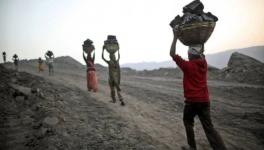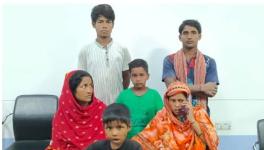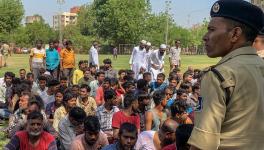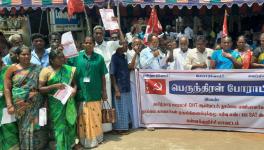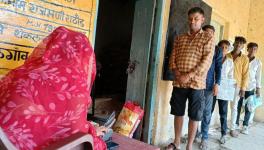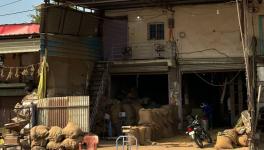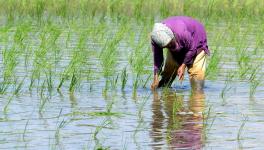All India Agricultural Workers Union Protest: ‘Ensure Workers’ Welfare and Strengthen Rural Economy’
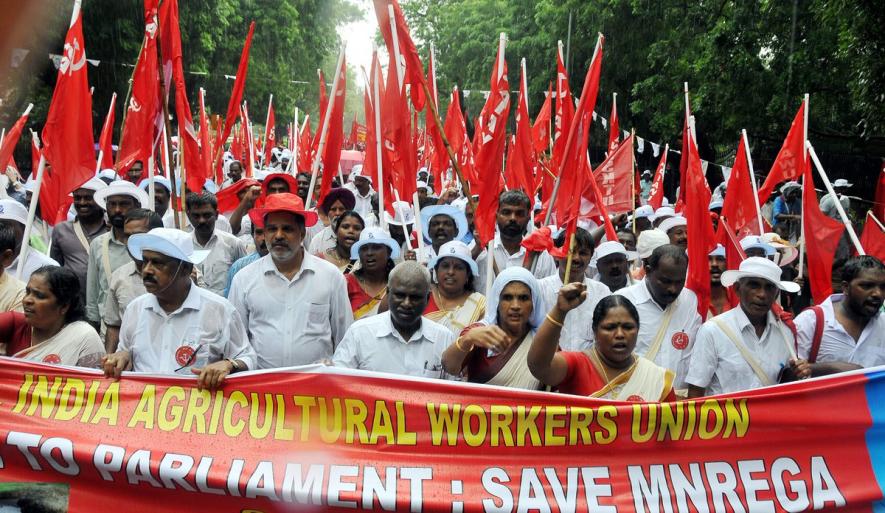
File Photo.
Experience of the last three months during a lockdown shows that even though the coronavirus does not differentiate between the rich and poor, people from different religions and castes, the measures undertaken to stop the infection—like unplanned lockdown—are mainly affecting the poor, working class, peasants and the marginalised sections of India. However, it is also true that the workers and the poor are more susceptible to the infection due their socioeconomic conditions often resulting in hunger, malnutrition and weak immunity.
Most of the damage in India is being done by the human made crises like the ill-planned lockdown. Working class of the country is going through very difficult times when their lives are exposed to the twin dangers of infection and the looming danger of starvation. The lives of the workers in the unorganised sector in urban and rural India are affected to a greater extent. The impact of the lockdown is increasingly visible in the intensifying miseries of the people at large.
Agricultural workers and the rural poor are the worst affected by the lockdown crisis and the policies of the Modi Government. The rural proletariat is facing absolute poverty and an unprecedented level of unemployment. In addition, the forced reverse migration is worsening the situation beyond imagination. The number of agricultural workers is more than 14.43 crore (according to the 2011 census) who also work as rural workers, migrant workers and under MGNREGA. Since most of them are not landowners and therefore, most government schemes do not cover them. These conditions have compelled them to opt for the path of struggle. As the government is not ready to listen to their miseries during this time of crisis, they have decided to make their voice heard. All India Agricultural Workers Union, an organisation of these workers with more than 75 lakh members, has given a call for an all-India protest on June 4, 2020.
This protest will be organised across the country in front of the respective district collectorates, BDO offices, other relevant administrative offices, Panchayat offices and MNREGA work sites according to the conditions in each state on the following issues and demands.
Failure of the Central Government in Managing the Crisis
The central government and most of the states, except Kerala, have failed to address the issues of working class and poor people during the lockdown. It is a hard reality that Indian economy is going to take a severe hit due to the lockdown, but the worse is the plan of the central government to transfer the brunt of this loss on to the working class. The first and immediate impact of the lockdown was on the workers of the unorganised sector, migratory workers, rural workers including agricultural workers. Overall, there is a huge increase in unemployment. According to Mahesh Vyas, managing director and CEO of the Centre for Monitoring Indian Economy (CMIE), India is looking at a loss of 14 crore jobs in India and the unemployment rate for this quarter is about 26%. According to the United Nations, after the lockdown, more than 40 crore people in India are going to face a serious threat of poverty and hunger. This loss in the employment opportunities is equal in urban as well as rural India. Rural workers, especially the agricultural workers, have lost the harvesting season due to the lockdown despite the fact that agricultural activities were kept out of the lockdown.
Reverse Migration and Rural Unemployment
It is important to understand that rural India has seen a number of changes due to the lockdown; reverse migration is one of the major changes. Crores of migrant workers who had gone to urban areas and to rural areas of other states in search of livelihood are back to their native places due to loss of their employment under the lockdown. Migrant workers have been forced to starve, sleep under the open sky in the cities, live in inhuman conditions at the shelter homes, walk thousands of kilometres to travel to their native places, and sell their last of the belongings to purchase train tickets back to home. Hundreds of workers have died during their travel back home. More than 400 deaths took place during the lockdown which cannot be attributed to medical reasons. According to the SAVE Life Foundation, 58 workers died during their journeys to their home states. Those who made it had to bear with inhuman conditions at the quarantine centres and the social stigma of being viewed as a potential carrier of the novel coronavirus. Now, another struggle awaits them; they have to look for a source of livelihood again. This reverse migration has increased the workforce in rural India with decreased opportunities of work.
Lower Wages
Various reports say that with returning of migrant workers to the village, the competition for agricultural work has increased manifold, further decreasing the average working days of each household and lowering the wage rate. In some districts of Punjab, rich farmers, using their influence, have forced panchayats to announce lower wage rates. They have also imposed restriction on the movement of workers from one village to another. These are peculiar conditions when there will be more attacks on the wages, especially of the women.
MNREGA as a Solution for Revival of Rural Economy
The national rural employment guarantee scheme can work as a lifeline for the revival of the rural economy. But, the complete approach of the central as well as the state governments has to be altered to make it possible. The finance minister has announced an allocation of Rs 40,000 crore for MNREGA. It was claimed by the finance minister that migrant workers who have returned home will be supported through MNREGA. However, the total budget available for the MNREGA does not concur with her claims.The allocated amount under MNREGA in the budget for 2020-21 is Rs 61,500 crore, which is Rs 9,500 crore less than the spending on MNREGA in the year 2019-20. There are huge pending dues from the last year. With the announcement of Rs 40,000 crore, the total amount available for MNREGA adds up to Rs 1,01,500 crore.
As per MNREGA portal accessed on May 16, overall, 1435.73 lakh people have applied for job cards and 1374.39 lakh cards have been issued. This means that there are 61,35,751 registered households to whom job cards have not been issued. Out of these, only 766.75 lakh job cards are active with 1,166 lakh active workers. If we follow a simple calculation for the provision of work for 100 days with Rs 200 daily wage for the active workers, there is a need of Rs 1,53,350 crore. To provide 100 days of work to all families with job cards, it will require Rs 2,87,146 crore. Moreover, in the prevailing economic crisis, there is a need to provide a minimum of 200 days of work to each household. Going by this, it will cost the exchequer Rs 3,06,700 crore. It is also important to underline that a wage of Rs 200 is far too little, but nonetheless we are considering this as the minimum wage. The above calculations are only for the wage component, but there are other expenses also involved in MNREGA work. Also, these statistics were based on the earlier existing workforce in the villages.Now, add to this the millions of migratory workers returning to their villages. Irregular and inadequate release of funds by the Centre and inability of the state governments to contribute their share because of their poor financial situation has seriously affected the implementation of the MNREGA.
Hunger and the Public Distribution System
Hunger deaths have been reported from different corners of the country. Initially, the government had come up with a proposal of distribution of 5 kg of rice/wheat to every head and one kg of pulses and edible oil to each ration card holder. According to their claim, 80 crore beneficiaries were targeted, but only 60 crore people have benefited. After much pressure from various people’s organisations, compulsion of a ration card was withdrawn. But in practice, only ration card holders are getting ration from PDS. Particularly in the rural areas, the condition of families, with respect to the intake of calories, proteins, and micronutrients is inferior. PDS of Kerala is one of the best models in India that has successfully distributed a comprehensive package of food grains and other essential items to the needy. The Food Corporation of India has almost 7.6 crore of tonnes of food grains in the stores. The Rabi crop will add about 3.5 crore tonnes to this store. We have much extra in storage than required and this should be used for the universal PDS.
Direct Monetary Support
Working class of the country, especially the urban unorganised sector and rural workers, are without any income for the last 55 days. Their purchasing power has been exhausted. This is leading to a lack of demand in the market. The central government is not paying heed to the suggestions of the workers and peasant organisations, which are demanding transfer of Rs 7,500 to the accounts of the non-tax payers for three months. Transferring this amount would be an appropriate strategy to save crores of families dying of hunger. Similar suggestions have been made by various noted economists including Nobel laureate Abhijit Banerjee who has recommended the direct transfer of money to more than 60% of Indians to not only help the poor, but also to revive the economy.
Health Services
The health system of the country has collapsed during the prevailing crisis. Even as a large number of posts of doctors and paramedical staff are vacant, overburdened medical staff are fighting the battle with COVID-19. In addition, critical ailments are not being treated in many hospitals, pregnant women are not getting medical care and aged people are forced to live with their suffering of old age-related disease in absence of doctors. This trend will worsen in the coming days.
Land Issue
Ruling class in not only targeting the workers through dilution of labour laws, but has also taken Ordinance route to dilute Agricultural Produce Marketing Committee Act (APMC Act) to allow private-owned markets and remove all control over farm-produce markets, implement Model Contract Farming Act, 2018, Model Tenancy Act or Agricultural Land Leasing Act, overturn land reform laws to allow corporate takeover of farmlands as well as for the electricity sector privatisation. The ruling classes are seizing the opportunity to dispossess the peasantry. We demand that all such efforts be stopped and all government and surplus land be distributed to the landless and agricultural workers.
So, to summarise, following are the key demands to be raised during the all-India protest:
- Distribute Rs 7,500 to all households for three months immediately
-
Give pecial assistance to migrant workers in their native villages and compensation to the families of the migrant workers injured or deceased in accidents, or due to hunger or suicide
-
Provide 200 days of work with either Rs 600/day or the minimum wage in the states, whichever is higher, and unemployment wages to job card holders. Allocate additional Rs 100,000 crore for MNREGA
-
Distribute 10 kilograms of rice/wheat and other essential items for free through the Public Distribution System for the next six months to all without any compulsion of ration cards
-
Arrange a proper health check-up of citizens, especially in rural India, through the public health system
-
Stop the dilution of labour laws
-
Stop the disinvestment of public sector units and investment of FDI in various sectors with immediate effect
-
Stop all efforts to implement Model Contract Farming Act, 2018, Model Tenancy Act or Agricultural Land Leasing Act to dispossess farmers, distribute all government and surplus land to the landless and agricultural workers
Author is associated with AIAWU.
Also read: Public Display of Faith Can Wait, Humanity Cannot
Get the latest reports & analysis with people's perspective on Protests, movements & deep analytical videos, discussions of the current affairs in your Telegram app. Subscribe to NewsClick's Telegram channel & get Real-Time updates on stories, as they get published on our website.









